Yes, that Baby Face Nelson. . . .
What better place for a wanted man to spend a quiet month hiding from the feds than the cabins of an out-of-the-way tourist resort. Walley’s Hot Springs, Nevada, to be precise.
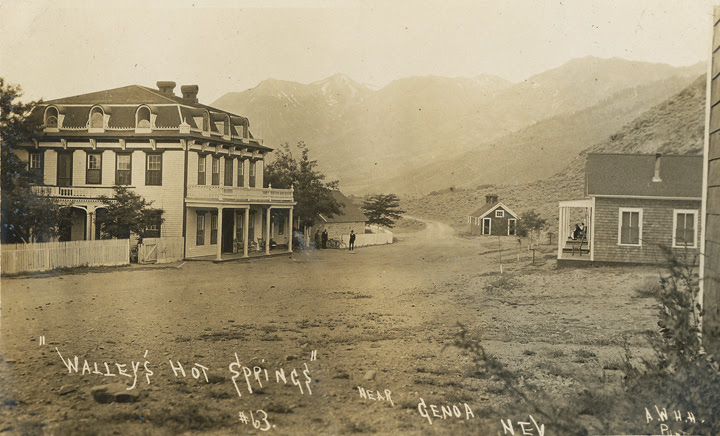
On October 1, 1934, Lester Joseph Gillis, aka George Nelson, aka “Baby Face” Nelson registered as a guest at Walley’s resort. Not under any of those names, of course. With him were his wife, pretty 25-year-old Helen Wawrzyniak Nelson; accomplice John Paul Chase; and several other members of his gang.
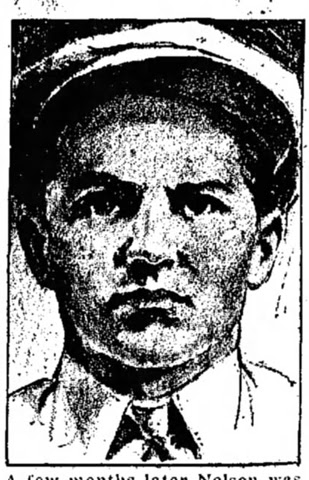
A native of Chicago, Nelson stood just under 5-foot-5 tall, with light chestnut hair and “yellow and gray slate” eyes. He was not yet 26. But he’d already racked up an impressive criminal history..
As a young teen, Nelson got sent to reform school at age 12 for accidentally shooting a companion. At 13 he was arrested again, this time for joyriding, and another 18 months was tacked on to his youthful sentence. When he finally got out of the reformatory in April, 1924, Nelson was 15 – but hardly reformed.
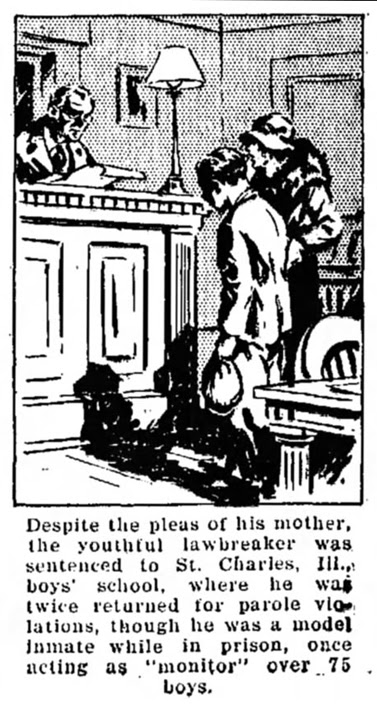
He joined a group of young tire thieves run by the infamous Touhy gang, and delivered bootleg alcohol to the suburbs.
In 1928, when he was twenty, Nelson married Helen Wawrzyniak. Their first child, Ronald, was born in 1929. Daughter Darlene would follow in 1931.
Nelson now was a family man. But he wasn’t inclined to support his family the traditional way. His life of crime escalated to home invasion and bank robberies. And in 1931, he snagged a felony sentence for a robbing a bank in Illinois.
Sentenced to a “year to life” at Joliet Penitentiary, he was being escorted back to the prison after (some say) testifying against an associate when he slugged a guard on February 17, 1932, and made his escape.
Underworld friends with the Touhy gang in Chicago helped Nelson make his way west. He arrived in Reno about March, 1932, connecting with underworld figures Bill “Curley” Graham and “Cinch” McKay. Worried he’d eventually be recognized, they sent him to San Francisco, and he soon wound up running Prohibition liquor for a time for bootlegger Joe Parente out of Sausalito.
But before long, he was back in Reno. Using the assumed name of James (“Jimmie”) Burnell, Nelson worked as a “chauffeur” for Graham and McKay. From October, 1932 to February, 1933, he and Helen lived on Caliente Street in Reno, with at least one of their young children joining them part of that time.
From mid-1933 to early 1934, Nelson and his gang associates pulled a series of brazen bank robberies and other crimes all across the country: Grand Haven, Michigan; Brainerd, Minnesota; San Antonio, Texas; Sioux Falls, South Dakota; Mason City, Iowa.
But by March, 1934, it seems, Nelson was back in Reno – his name was later connected to the murder of banker Roy Frisch, who disappeared from sight March 22, 1934 (just prior to a scheduled federal court appearance to testify about a Reno-based bunco ring with tentacles that had stretched nationwide.) Frisch’s body was never found.
And then the clincher: On April 27, 1934, during a botched FBI attempt to capture on underworld figure John Dillinger at a Wisconsin resort, Nelson shot and killed FBI agent Carter Baum. With Dillinger’s own demise about three months later, Nelson now became Public Enemy Number One.

In the coming months, even wife Helen was dodging the law. She had been put on probation for “harboring” a fugitive (probably her husband). But now on the run with Nelson, she failed to stay in touch with her probation officer. Helen’s probation was revoked in mid-June, 1934, and a warrant was issued for her arrest.
By now, the heat was definitely on. Nelson and his gangland pals bounced around “auto courts” (early motels) in Nevada and California, trying to stay one step ahead of the law. In August, 1934, Nelson was suspected of robbing a store in Alturas, California, making off with not only cash and jewelry but also guns and ammunition. Nelson and friends also came to Carson Valley several times, hunting pheasant – out of season, of course.
Nelson also put in an appearance in Gardnerville at least twice – though nobody recognized him at the time. He stopped in at C.C. Meneley’s Sierra Park once to inquire about renting a quiet cabin “off by itself.” (He was out of luck; Meneley informed him there were none.) And on a different occasion Nelson pulled up in a blue coupe at Fritz Luhr’s barber shop, and calmly stopped in for a shave – and a bit of gossip. Among other details, he managed to wangle a description of the local constable and the make and model of sheriff’s car.
Eventually, Nelson stumbled across what seemed like the perfect hideout right here in Carson Valley: David Walley’s old-time resort. A mile south of Genoa, it was quiet and off the beaten path. Built in 1862 by David Walley and added onto over the years, it once had boasted 40 rooms, 11 baths, with all the amenities: ballroom, swimming pool, bathhouses, and even a doctor in residence.
By 1934 that glory had largely faded. Still, Walley’s seemed to offer everything a wanted man could ask for in the way of peace, quiet, and isolation. There were tasty chicken dinners, and even dancing on weekends with a band for entertainment.
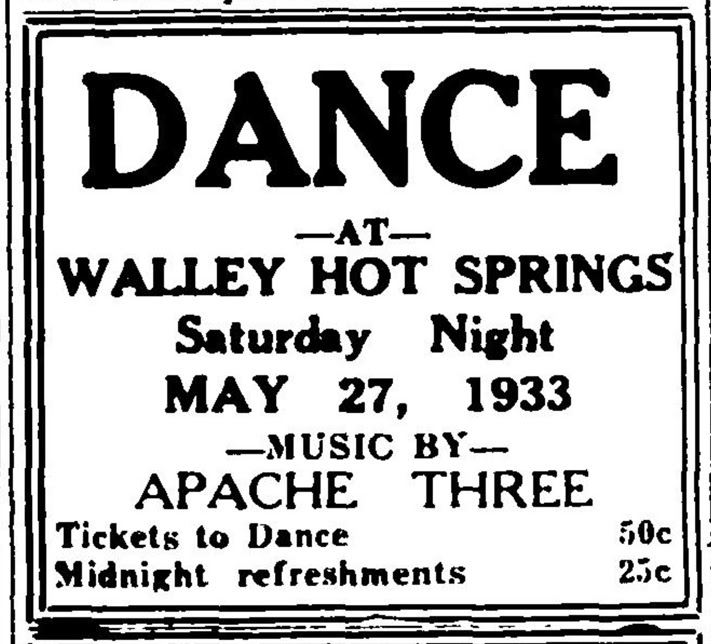
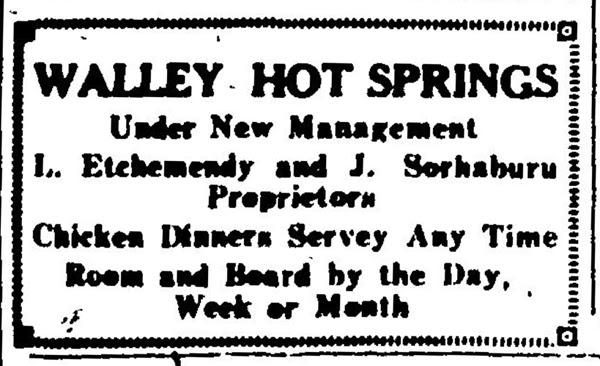
Nelson, Helen, John Paul Chase and several other underworld compatriots settled in there at Walley’s about October 1. They would remain there for roughly a month.
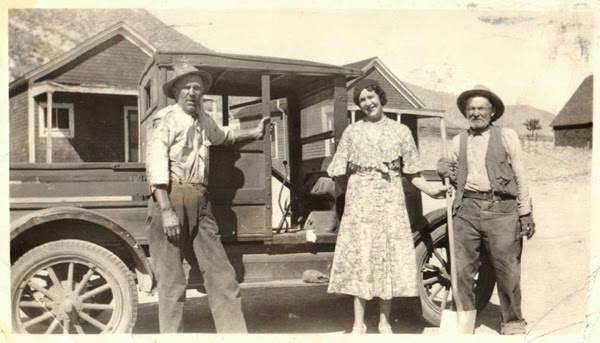
But eventually federal agents began poking around – and, according to historian Michael Fischer, only narrowly escaped a fiery confrontation. Nelson, it seems, had been warned the feds were coming and was waiting for them on the hillside, rifle in hand. Luckily for the G-men, one agent looked at his watch as they pulled off the road at Walley’s and realized he was late to meet his mother-in-law’s train at Reno. The car turned around without spotting Nelson – and without investigating further.
Now, even the wilds of Carson Valley were no longer a safe hide-out. The gang high-tailed it out of town – first to Hawthorne, where they spent several days living in a tent on the outskirts of town, then finally back to Chicago.
And there, on November 27, 1934, Nelson’s life came to an abrupt end after he was recognized by a pair of FBI agents. Lurid newspaper accounts reported that Nelson’s bullet-ridden body was found in a ditch not far from the site of the shoot-out.
The truth was sadder still. Nelson actually survived the shoot-out briefly. He was whisked away in the dead FBI agents’ car by wife Helen and associate John Paul Chase, to a house on Walnut Street in Niles Center (now Skokie), Illinois. Nelson died there, with Helen holding his hand, just hours later. The surviving gang members dropped Nelson’s bloodied, blanket-wrapped body beside a nearby cemetery. If he’d lived nine days longer, he would have been 26 years old.
With Helen still on the run, the Cook County Medical Examiner’s office exhibited Nelson’s body to the public. Two government agents stood by, scanning the faces of the women who came to view the body, “ready to arrest anyone showing signs of grief.”
“Lester really wasn’t a bad boy,” his mother would tell reporters back in Chicago. “They made him like that.” His sister, Juliette, also took her brother’s part. Nelson had been “greatly wronged and misunderstood,” she insisted.
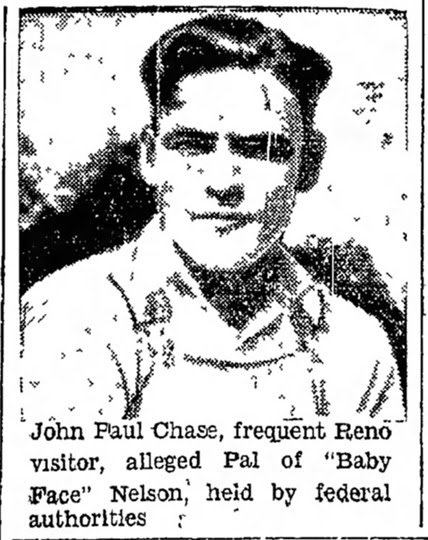
Justice finally caught up with accomplice John Paul Chase in late December, 1934. Other gang associates were still in hiding as late as February, 1935, though a machine gun was said to have been found in the Truckee River. Reno residents “Tex” Hall and Frank Cochran were convicted in San Francisco federal court in spring 1935 of “conspiring to harbor” Nelson.
As for Helen, she surrendered herself to authorities soon after her husband’s death, and made “revelations” that helped produce 17 fresh gang indictments. After serving out the rest of her earlier sentence, she was released in September, 1935.
Helen never remarried, and led a quiet existence until her death on July 3, 1987 at the age of 73. She was buried at St. Joseph’s Cemetery in River Grove, Illinois, next to her husband, the love of her life, Lester Joseph Gillis, aka Baby Face Nelson.
________________
